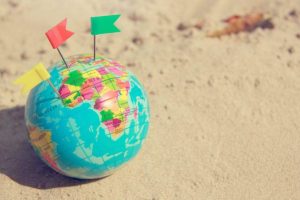
Deaf Travel and Tourism: Breaking Barriers and Creating Accessible Adventures
- Posted by Cicada Sign
- Categories Blog
- Date December 5, 2024
- Comments 0 comment
Traveling offers a unique lens through which individuals experience the world. For the Deaf community, traveling comes with its own set of challenges and opportunities. From navigating language barriers to creating connections through sign language, Deaf travelers are breaking barriers and redefining the tourism experience. In this blog, we’ll explore real-life stories of Deaf travelers, highlight resources to support inclusive travel, and share tips to make the travel industry more accessible.
Real-Life Stories of Deaf Travelers
Calvin Young – Founder of “Seek the World”
Calvin Young, a Deaf traveler and vlogger, created Seek the World to document his adventures and educate people about Deaf culture through travel. His inspiring stories reveal how he’s tackled communication barriers with tools like smartphone apps and handwritten notes. For example, in India, he leveraged pointing and drawing gestures—techniques often used locally due to linguistic diversity—to navigate cultural and linguistic challenges effectively.
Learn more: Seek the World
Stacey from “Deafinitely Wanderlust”
Stacey, the founder of Deafinitely Wanderlust, uses her platform to share insights and challenges faced by Deaf travelers. Through her travels, she’s learned multiple sign languages, including International Sign Language, Mexican Sign Language, and Korean Sign Language. Stacey’s blog highlights how technology, patience, and written communication help her navigate tricky situations, such as being misdirected on a train in China.
Read her blog: Deafinitely Wanderlust
Challenges in Deaf Travel
Deaf travelers often face hurdles such as:
- Communication Barriers: Limited visual announcements in airports, train stations, or hotels can lead to confusion and missed opportunities.
- Stereotypes: Some tourism professionals mistakenly assume Deaf travelers cannot participate in certain activities, creating unnecessary exclusions.
- Limited Access to Visual Information: Inconsistent availability of captioning, interpreters, or written alternatives in guided tours or events.
Despite these obstacles, Deaf travelers have found ways to overcome them through advocacy, education, and innovation.
Breaking Barriers: Tools and Resources
The travel industry is gradually becoming more inclusive, thanks to the advocacy of the Deaf community and the advent of supportive technologies. Here are some useful tools:
- Communication Apps: Real-time transcription apps like Google Translate or Notes apps can bridge gaps.
- Deaf-Friendly Platforms: Travel-focused organizations like Wheel the World promote inclusivity for travelers with disabilities.
- Local Connections: Social media platforms and Deaf travel groups help connect with Deaf locals for unique, culturally rich experiences.
How the Travel Industry Can Improve
- Accessible Infrastructure: Airports, hotels, and public transportation hubs should invest in visual alert systems, captioning services, and sign language interpreters.
- Training for Staff: Hospitality professionals need Deaf awareness training to better accommodate and communicate with Deaf travelers.
- Representation in Marketing: Featuring Deaf travelers in campaigns promotes inclusivity and normalizes their experiences.
Cicada Sign’s Perspective
At Cicada Sign, we believe in celebrating diversity and amplifying the voices of the Deaf community. Through education and advocacy, we aim to inspire industries to prioritize inclusivity and accessibility. By showcasing stories of Deaf travelers, we hope to motivate the travel industry to continue breaking barriers.
Traveling as a Deaf individual can present unique challenges, but the triumphs far outweigh the obstacles. By fostering inclusivity and supporting Deaf-friendly practices, we can make the world a more accessible place for everyone. Let’s celebrate Deaf travelers who are proving that adventures have no boundaries.





